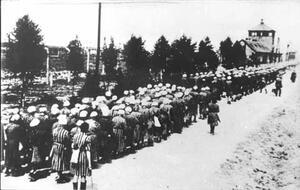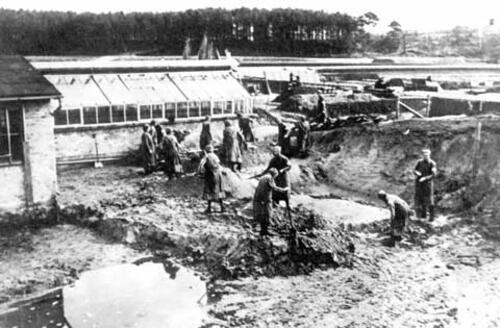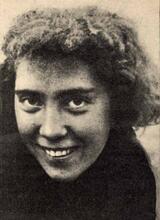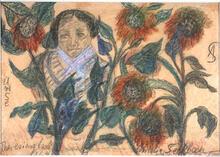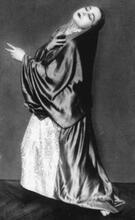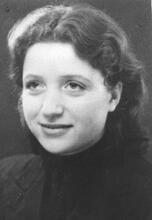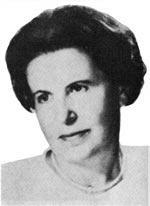Ravensbruck Women's Concentration Camp
Ravensbrück was inaugurated by the Nazis in 1939 to serve as a model concentration camp for female political prisoners, initially housing the Nazis’ political enemies, some of whom were Jewish. Over the six years the camp was in operation, thousands of political prisoners, Jehovah’s witnesses, criminals, and those deemed “asocial”—a category that included both lesbians and the Roma-Sinti—were deported to Ravensbrück, located about 50 miles from Berlin. Prisoners became slave laborers and the victims of numerous torturous actions. As more and more prisoners arrived at Ravensbrück to exceed acceptable capacity, the already miserable rations and housing conditions were stretched even more thinly. By the end of the war and the camp’s liberation in 1945, some 132,000 women and children had been imprisoned in Ravensbrück.
Introduction
Ravensbrück, the concentration camp that the Nazis created to incarcerate women, received its first transport of prisoners in the spring of 1939. While not created as a camp specifically for Jewish women, they were among the camp’s inmate population for nearly all of its six-year existence. Of the total of some 132,000 women and children who were imprisoned in the camp, some 20 percent were Jewish. The others were political prisoners (some of whom were also Jewish), Jehovah’s Witnesses, criminals, and those deemed “asocial”—a category that included both lesbians and Gypsies. At least one of the women who was imprisoned and ordered murdered at the camp, Henny Schermann, was arrested as both a lesbian and a Jew. Like the term “asocial,” the term “criminal” has to be taken in its Nazi context. While it might refer to a woman who fits our own concept of a criminal, for example a thief or a murderer, it also included women who broke Nazi-imposed laws. Even the term “political prisoner” was broad, including resistance fighters, those who helped Jews, members of the Soviet Army, and a small number of women (one of whom was Jewish) held as hostages because they had powerful relatives. Each category had its own colored triangle, sewn on the women’s uniforms: red for political, purple for Jehovah’s Witnesses, black for asocial, green for criminal, and yellow for Jews. If Jewish prisoners were also classified as political, they wore both a red and a yellow triangle, arranged as a Star of David. Jewish women were always set apart by their “race” on camp lists, even when they were also in another category.
Ravensbrück concentration camp was located about 50 miles from Berlin near the town of Fürstenberg and is today an official memorial site of the state of Brandenburg. When the camp was inaugurated, it was intended as a model concentration camp for female political prisoners. The first transport of 867 women arrived in May 1939. They were mostly German anti-fascists, either Social Democrats or communists (some coincidentally Jewish), as well as Jehovah’s Witnesses. The prisoners arrived from Lichtenburg in Saxony, a fortress that had been used as a women's camp from March 1938 until May 1939. Before that, from October 1933 until March 1938, the first women’s camp was located in a workhouse in Moringen, near Hanover, but women were generally incarcerated in prisons during the early years. While there were Jewish prisoners in the camp from its first days, no Jewish woman who was there during its first three years survived.
Slave Labor and Other Torture Tactics
In addition to incarcerating and punishing female political and other prisoners, in its early days the camp began to use the women as slave laborers as Germany prepared for war. After the invasion of Poland initiated World War II in September 1939, transports arrived every day from the countries that became occupied by the Nazis. The imprisoned women were forced to work at many kinds of slave labor, from heavy outdoor physical labor to eventually building V-2 rocket parts for the Siemens Electric Company. The camp also had a courtyard with factories to make and repair clothing, and other related industries.
The “Bunker,” a building of cellblocks completed in 1939, served as the camp prison, where solitary confinement and torture soon became routine. During the entire time of its existence, Ravensbrück also served as a centralized training camp for newly hired female SS-employed guards and overseers who were then transferred to other camps, such as Auschwitz or Majdanek. Although the camp is not generally classified as a death camp, women died there of overwork, starvation, disease, shooting, poisoning, “medical” experiments, lethal injections, deliberately incited dog bites, beatings, and torture. Some women were sent to euthanasia facilities to be gassed. For a short time during the camp’s last months, there was a functioning gas chamber at Ravensbrück.
Growth of the Camp, Worsening of Conditions
One cannot present a monolithic picture of conditions at Ravensbrück because they continued to worsen with time. By May 1940, a year after the camp opened, the number of inmates already exceeded the original capacity of 3,000. By the summer of 1941 there were about 5,000 women, and in April 1942 about 6,400 female inmates were listed in the ledger counts. The increased population caused a dramatic worsening of camp conditions. In mid-1942 and afterward the camp was enlarged several times, with the women prisoners doing much of the construction. As the population grew to more than ten times the originally planned number of women, the living conditions and treatment rapidly deteriorated. Between May 1939 and June 1944, 43,000 women were brought to Ravensbrück. Throughout the camp’s history, Jewish women generally were singled out for harsher work and fewer, if any, privileges. (For example, other prisoners could sometimes send and receive mail.)
The only exception to the growth of the camp’s population was between February and April 1942, because about 1,500 prisoners, including at least 700 to 800 Jewish women, were sent to Bernberg, a euthanasia facility, and murdered by gassing in the so-called “14 F 13” project. There was also a transport of 1,000 Jewish women to Auschwitz on March 26, 1942, and another 522 Jewish women were sent there on October 6, 1942. These actions were part of Himmler’s command to make camps in the territories within the German Reich free of Jews. However, this judenrein situation did not last long, and in a matter of weeks, or two months at most, there were again Jewish prisoners in the camp. Camp records account for about 10,000 (Jewish and non-Jewish) new arrivals in 1943, and in 1944 more than 70,000 inmate numbers were given out.
In January 1944, about 17,300 prisoners were held in Ravensbrück, but by December there were 32,050, according to figures used at the camp memorial. The conditions, with so many women living together, were unimaginable. Some of the barracks built for a maximum of 250 women eventually housed as many as 2,000, with three or four to a bunk. Thousands of women did not even have part of a bunk, but lay on the floor without even a blanket. Already insufficient rations became more and more meager as time went on.
When Jewish women arrived from Hungary in the fall of 1944, there was no place to put them and a big tent with a straw floor was erected. The women lay in their own dirt in the freezing cold, and died in masses. The tent, “housed” Hungarian Jews as well as women evacuated from Auschwitz, and up to three thousand women were left to perish with virtually no water, food, or blankets.
Because of the changes in the situation at the camp during its six years of existence and the destruction of many records by the Nazis as the Soviet Army approached, it is difficult to present a complete and accurate picture. This is particularly true regarding the fate of the Jewish victims, because thousands of them arrived during the camp’s chaotic last months and often were not accounted for.
Legacies of Jewish Prisoners
Among the Jewish women who survived and recorded their recollections on Ravensbrück (Saidel, 2004), none arrived before the end of 1942. It is rare to find a Jewish survivor who arrived before 1943 or even during that year. The majority of the camp’s Jewish survivors arrived after Auschwitz was evacuated in January 1945. Most were sent on to satellite camps, and some remained at the main camp until liberation by the Soviet Army at the end of April. The Red Cross rescued about a thousand Jewish women from the camp toward the end of the war and brought them to Sweden to recuperate.
Jewish prisoners were among those women who eased their comrades’ and their own psychological suffering by sharing small homemade gifts, educational sessions, poems, dramatizations, and recipes. Early Jewish political prisoners Olga Benário Prestes (a German communist) and Dr. Käthe Pick Leichter (an Austrian Social Democrat) even collaborated on a clandestine newsletter. Leichter also wrote poetry and Prestes made a secret atlas to accompany her geography lessons. Creating recipe books or cookbooks was a form of resistance unique to women, because it enabled them to use their homemakers’ skills to cook in words and remember better times at home. Often the recipes were shared orally, but sometimes the women were able to write down their remembered recipes. Despite the harsher conditions for Jewish prisoners, at least two recipe books compiled by Jewish women survived.
Ravensbrück and the story of its Jewish female victims have not received sufficient recognition in Holocaust memorialization. Many of the camp’s Jewish victims did not live to tell their stories. The majority of those who survived came to Ravensbrück after Auschwitz was evacuated. Most of them arrived extremely weak and ill, and Auschwitz is the focus of their memories. Furthermore, the camp’s location in the German Democratic Republic and the communist survivors’ leadership in commemorations and writings before the reunification of Germany gave the impression that this camp was not part of the Nazis’ attempt to achieve the Final Solution of the Jewish people. However, an estimated 26,000 Jewish women passed through or were murdered at this camp. Hundreds of Jewish survivors from the United States, Israel, and elsewhere joined others at the camp memorial for the 50th anniversary of its liberation in 1995, and awareness of the camp’s Jewish victims has gradually grown.
Anthonioz, Genevieve de Gaulle. The Dawn of Hope: A Memoir of Ravensbrück. New York: Arcade Publishers, 1999.
Bernstein, Sara Tuval. The Seamstress: A Memoir of Survival. New York: Berkley Books,1997.
Buber-Neumann, Margarete. Under Two Dictators. London: V. Gollancz, 1949.
Buber-Neumann, Margarete. Milena: The Tragic Story of Kafka’s Great Love. New York: Arcade Publishers, 1988.
Delbo, Charlotte. Auschwitz and After. New Haven: Yale University Press, 1995.
Dufournier, Denise. Ravensbrück: The Women’s Camp of Death. London: G. Allen & Unwin, 1948 (1970).
Feig, Konnilyn. Hitler’s Death Camps: The Sanity of Madness. New York: Holmes & Meier, 1979.
Gluck, Gemma LaGuardia, edited by S. L. Shneiderman. My Story. New York: 1961;
Herbermann, Nanda. The Blessed Abyss: Inmate #6582 in Ravensbrück Concentration Camp for Women, edited by Hester Baer and Elizabeth Baer. Detroit: Wayne State University Press, 2000.
Langley-Dános, Eva. Prison on Wheels: From Ravensbrück to Burgau. Einsiedeln: Dalmon Verlag, 2000.
Maurel, Michelene. An Ordinary Camp. New York: Simon and Schuster, 1958.
Morais, Fernando. Olga: Revolutionary and Martyr. New York: Grove, 1990.
Morrison, Jack. Ravensbrück: Everyday Life in a Women’s Concentration Camp 1939–1945. Princeton: Wiener, 2000.
Póltawska, Wanda. And I Am Afraid of My Dreams. New York: Hodder & Stoughton, 1987.
Saidel, Rochelle G. The Jewish Women of Ravensbrück Concentration Camp. Madison, Wisconsin: University of Wisconsin Press, 2004.
Saidel, Rochelle G. “Ravensbrück Women’s Concentration Camp: Before and after Liberation.” In Remembrance, Repentance Reconciliation: The 25th Anniversary Volume of the Annual Scholars Conference on the Holocaust and the Churches, edited by Douglas F. Tobler. Lanham: University Press of America, 1998, 165–175.
Saidel, Rochelle G. “Integrating Ravensbrück Women’s Concentration Camp into Holocaust Memorialization in the United States.” In Women in the Holocaust: Responses, Insights and Perspectives: Selected Papers from the Annual Scholars’ Conference on the Holocaust and the Churches, 1990–2000, edited by Marcia Sachs Littell, Merion: Merion Westfield Press International, 2001, 63–74.
Saidel, Rochelle G. “Ravensbrück Concentration Camp and Rescue in Sweden.” In Remembering for the Future: The Holocaust in an Age of Genocide, Volume 3: Memory, edited by John K. Roth and Elisabeth Maxwell. London: Palgrave, 2001, 172–188.
Saidel, Rochelle G., Curator. Women of Ravensbrück, Portraits of Courage: Art by Julia Terwilliger (exhibit catalogue). Saint Petersburg: The Florida Holocaust Museum, 2001.
Shelley, Lore, ed. Auschwitz: The Nazi Civilization. Lanham: University Press of America, 1992.
Sommer-Lefkowitz, Elizabeth. Are You In This Hell Too? London: The Menard Press, 1995.
Symonowicz, Wanda, editor. Beyond Human Endurance: The Ravensbrück Women Tell Their Stories. Warsaw: Interpress Publishers, 1970.
Ten Boom, Corrie. The Hiding Place. New York: Inspirational Press, 1971, 1983.
Tillion, Germaine. Ravensbrück. New York: Anchor, 1975.

